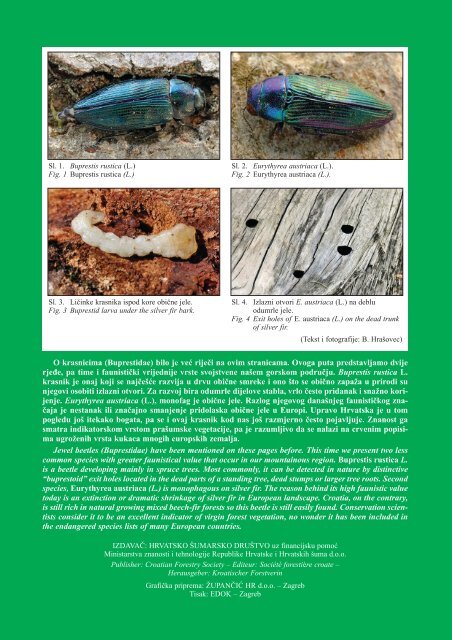PDF - HÅ D
PDF - HÅ D
PDF - HÅ D
You also want an ePaper? Increase the reach of your titles
YUMPU automatically turns print PDFs into web optimized ePapers that Google loves.
Sl. 1. Buprestis rustica (L.)<br />
Fig. 1 Buprestis rustica (L.)<br />
Sl. 2. Eurythyrea austriaca (L.).<br />
Fig. 2 Eurythyrea austriaca (L.).<br />
Sl. 3. Ličinke krasnika ispod kore obične jele.<br />
Fig. 3 Buprestid larva under the silver fir bark.<br />
Sl. 4. Izlazni otvori E. austriaca (L.) na deblu<br />
odumrle jele.<br />
Fig. 4 Exit holes of E. austriaca (L.) on the dead trunk<br />
of silver fir.<br />
(Tekst i fotografije: B. Hrašovec)<br />
O krasnicima (Buprestidae) bilo je već riječi na ovim stranicama. Ovoga puta predstavljamo dvije<br />
rjeđe, pa time i faunistički vrijednije vrste svojstvene našem gorskom području. Buprestis rustica L.<br />
krasnik je onaj koji se najčešće razvija u drvu obične smreke i ono što se obično zapaža u prirodi su<br />
njegovi osobiti izlazni otvori. Za razvoj bira odumrle dijelove stabla, vrlo često pridanak i snažno korijenje.<br />
Eurythyrea austriaca (L.), monofag je obične jele. Razlog njegovog današnjeg faunističkog značaja<br />
je nestanak ili značajno smanjenje pridolaska obične jele u Europi. Upravo Hrvatska je u tom<br />
pogledu još itekako bogata, pa se i ovaj krasnik kod nas još razmjerno često pojavljuje. Znanost ga<br />
smatra indikatorskom vrstom prašumske vegetacije, pa je razumljivo da se nalazi na crvenim popisima<br />
ugroženih vrsta kukaca mnogih europskih zemalja.<br />
Jewel beetles (Buprestidae) have been mentioned on these pages before. This time we present two less<br />
common species with greater faunistical value that occur in our mountainous region. Buprestis rustica L.<br />
is a beetle developing mainly in spruce trees. Most commonly, it can be detected in nature by distinctive<br />
“buprestoid” exit holes located in the dead parts of a standing tree, dead stumps or larger tree roots. Second<br />
species, Eurythyrea austriaca (L.) is monophagous on silver fir. The reason behind its high faunistic value<br />
today is an extinction or dramatic shrinkage of silver fir in European landscape. Croatia, on the contrary,<br />
is still rich in natural growing mixed beech-fir forests so this beetle is still easily found. Conservation scientists<br />
consider it to be an excellent indicator of virgin forest vegetation, no wonder it has been included in<br />
the endangered species lists of many European countries.<br />
IZDAVAČ: HRVATSKO ŠUMARSKO DRUŠTVO uz financijsku pomoć<br />
Ministarstva znanosti i tehnologije Republike Hrvatske i Hrvatskih šuma d.o.o.<br />
Publisher: Croatian Forestry Society – Editeur: Société forestière croate –<br />
Herausgeber: Kroatischer Forstverin<br />
Grafička priprema: ŽUPANČIĆ HR d.o.o. – Zagreb<br />
Tisak: EDOK – Zagreb
















